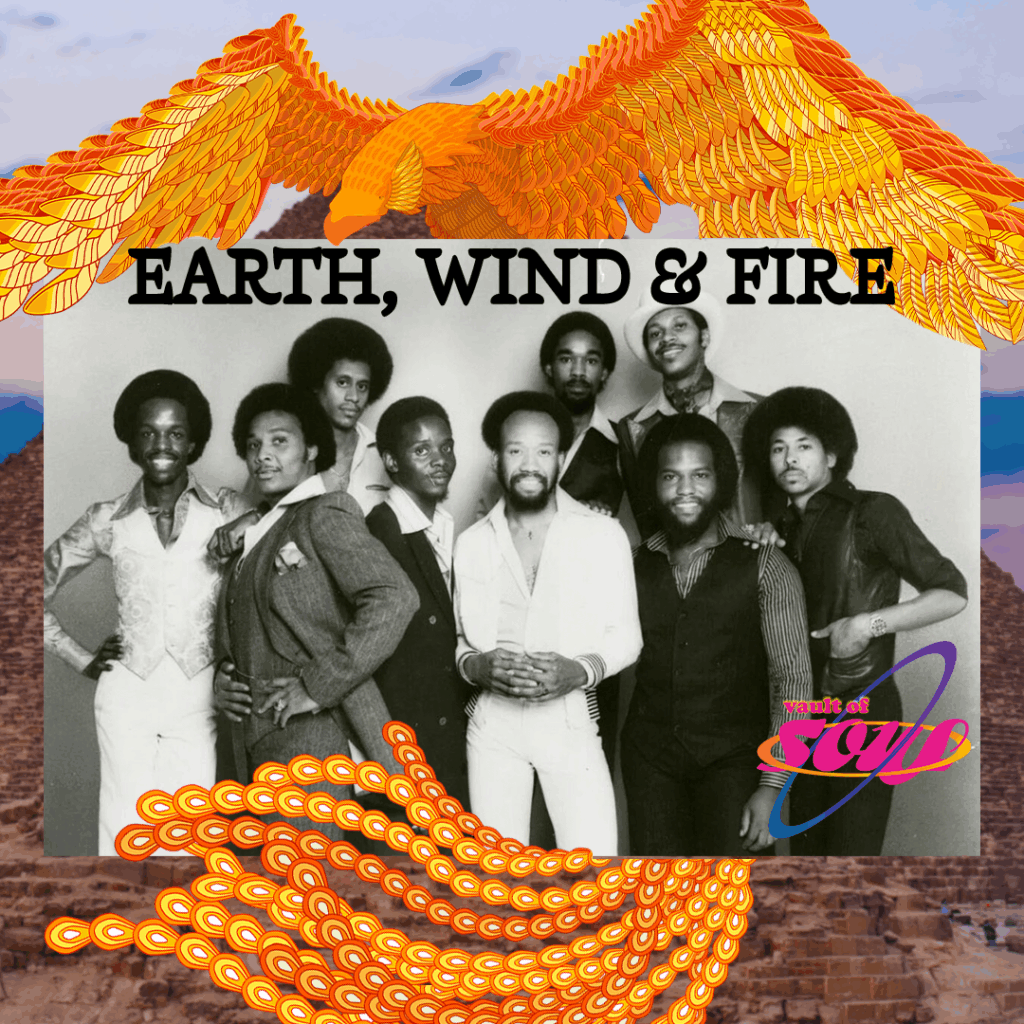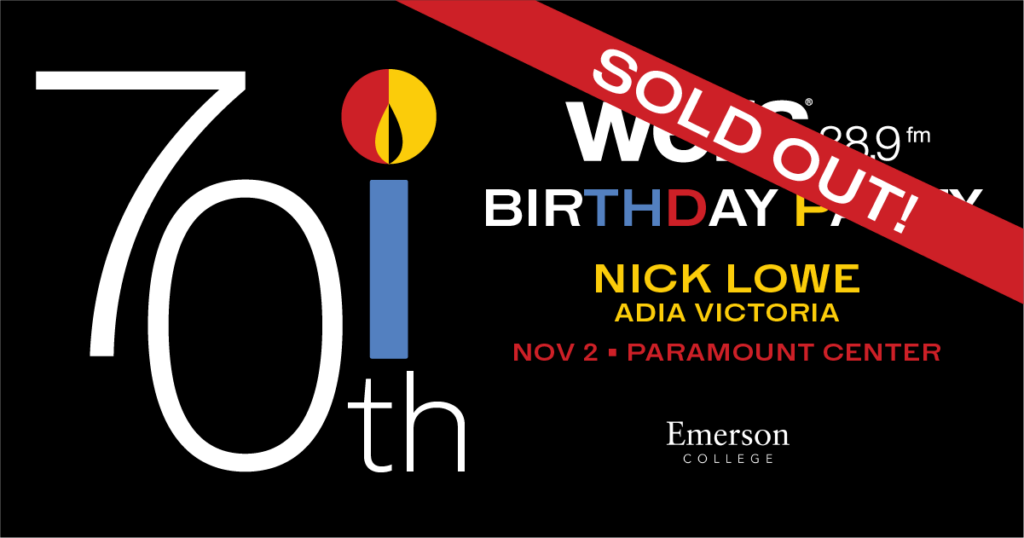
Graphics by RIley Vecchione
– By James Barnes, WERS/ERS+ Urban Coordinator
Each week of June, we open the 88.9 Vault of Soul with profiles of iconic soul pioneers. To continue 2025’s June coverage, WERS recognizes the legendary band Earth, WInd & Fire, one of the most influential bands of all time, blurring the lines between funk, soul, and R&B music.
Earth, Wind & Fire Continues Their Legendary Run
Since signing with Warner Bros Records in 1970, the legendary band Earth, Wind & Fire has achieved a great amount of commercial success, notching eight No. 1 hits and releasing over 23 albums, with several certified double platinum. They’ve had the privilege of performing for two former presidents – Bill Clinton and Barack Obama. The group has been honored on several occasions, including inductions into the Rock & Roll Hall of Fame, the Vocal Group Hall of Fame, and the NAACP Image Award Hall of Fame. They created a distinct sound of their own, combining funk, jazz, pop, soul, and R&B in their music. Most of their songs have been covered by other artists, further proving their undeniable influence on the music industry and how they paved the way for a host of current artists.
Biography
Earth, Wind & Fire originated in Chicago, IL, in 1969, formed by Maurice White. Prior to EWF, White began to set his mark as a session drummer for Chess Records. Maurice played for notables that included Billy Stewart, Fontella Bass and Etta James. It was as a member of the Ramsey Lewis Trio that Maurice learned about the African Thumb piano, the Kalimba. The use of it would add a signature sound to his work during his recording years. He went on to form a group called The Salty Peppers (under Capitol Records), which consisted of him and his two friends Wade Flemons and Don Whitehead. He recruited singer Sherry Scott, percussionist Yackov Ben Israel, and his younger brother Verdine after asking him to move to LA to be the band’s bassist.
The Salty Peppers became Earth Wind & Fire in 1970, but how did the band come up with new name? “Earth, Wind, & Fire” was derived from the elements of White’s astrological sign, Sagittarius; it’s primarily a fire sign with earth & air qualities. Auditions were held later in LA, and the band was finalized with a 10-man lineup. They released their debut self-titled album “Earth, Wind, & Fire” in March 1971. It contained their first top 40 hit, I Think About Lovin You. In 1972, Maurice dismantled the entire group, save for he and his brother Verdine. He rebuilt it with new musicians and vocalists that included Phillip Bailey, formerly of the group Friends and Love.
In 1975, the band released their 6th album, the soundtrack to the film “That’s The Way of the World”, which was directed by Sig Shore, producer of “Super Fly.” At first, EWF didn’t like the film and weren’t impressed with Shore’s offer to record the soundtrack, so they released the album before the film was released. This album went on to peak at No. 1 on Billboard’s 200 and was certified US triple platinum. The title track earned the group their first Grammy Award. From this same album, the single “Shining Star” emerged to No. 1 on Billboard Hot 100, solidifying the band as the first Black act to top both the Billboard album and single charts in 1975. After this album’s strong performance, the band formed their horn section, including the likes of saxophonist Don Myrick, trombonist Louis Satterfield, and trumpeters Rahmlee Davis and Michael Harris.
In 1978, EWF released their first greatest hits album titled “The Best of Earth, Wind, & Fire Vol. 1,” which featured one of their most successful singles, “September.” The song is so monumental that the Library of Congress chose to preserve the recording in the National Recording Registry, as being “culturally, historically, and aesthetically important.” Now, how legendary is that? By this time, EWF had found their way to television, performing for CBS under their subsidiary label of CBS Arc Records. They also released their aforementioned album under this label, and it rose to No. 3 on the Billboard charts.
Known as arguably the greatest band of all time, EWF is also known as one of the best-selling bands of all time, surpassing 90 millions records sold worldwide. On September 10, 2019, the LA City Council declared that September 21 would be observed as Earth, Wind & Fire Day. Their latest song, “You Want My Love,” was released on September 21, 2021, and it features R&B singer-songwriter Lucky Daye. This single was the first in 28 years to reach the top 10 of Billboard’s Adult R&B airplay chart. At the time of this writing, EWF are touring the US through the end of the year. Check out the dates and cities here.
A list of all former members of EWF can be found here.
Who Influenced Earth, Wind & Fire:
- Stevie Wonder
- The Isley Brothers
- Ramsey Lewis
- Sly & The Family Stone
- Memphis gospel music
- The Beatles
Who Earth, Wind & Fire Influenced:
- The Emotions
- The Roots
- Mint Condition
- 112
- Angie Stone
- Musiq Soulchild
- Meshell Ndegeocello
- Lalah Hathaway
- D’Angelo
- Bruno Mars and Silk Sonic
Awards & Honors (Few Excluded):
- 5 American Music Awards out of 12 nominations
- 7 Grammys out of 19 nominations
- BET Lifetime Achievement Award (2002)
- Hollywood Walk of Fame (1995)
- NAACP Hall of Fame Image Award (1994)
- Inducted into Rock & Roll Hall of Fame (2000)
- Inducted into Hollywood’s RockWalk (2003)
- Inducted into Songwriter’s Hall of Fame (2010)
- Inducted into Vocal Group Hall of Fame (2003)
- Legend Award at Soul Train Music Awards (2011)
- ASCAP Rhythm & Soul Heritage Award (2002)
- First black performers to receive Madison Square Garden Gold Ticket Award
- First black performers to receive Columbia Records Crystal Globe Award
- National Academy of Recording Arts & Sciences Signature Governor’s Award (2004)
- Maurice White & Philip Bailey received honorary doctorates from Berklee College of Music (2008)
- Lifetime Achievement Award at Trumpet Awards (2012)
- Major League Baseball Beacon of Change Award (2012)
- Hit-single “September” selected by Library of Congress for preservation in the National Recording Registry (2019)
Spotlight Tracks:
“September” (1978)
“September” is a joy-filled up-tempo song with high-energy funk and soul vibes. It has an infectious groove, a spirited horn section, and inspiring lyrics, all fused together to form a celebratory and nostalgic sound. Maurice White and Philip Bailey bless us with their smooth and soulful vocals. The dance rhythm comes from the bassline and guitar groove. The opening line is “Do you remember the 21st night of September?”, which we come to learn is Earth, Wind, & Fire Day. This song represents joy and musical brilliance.
“Let’s Groove” (1981)
“Let’s Groove” brings you this futuristic, funky vibe that slightly shifts toward an electro-funk and boogie type of sound. The signature energy, dance rhythms, and layered harmonies all remain. However, a talkbox is used in the intro with synth-heavy production to imitate a futuristic, space-age feel. The hook goes “Let this groove get you to move, it’s alright alright, alright”, giving us a sense of dancing and celebrating life.
“Reasons” (1975)
“Reasons” is a soulful ballad that demonstrates the band’s emotional depth and musical intelligence. It explores the complexity of love and desire. Philip Bailey’s falsetto in the chorus is the centerpiece to this beautiful masterpiece. The tempo of this song is slower than their usual dance grooves. It has more of a romantic feel to it, with string arrangements and lush harmonies. The lyrics are both loving and painfully true: “Reasons, reasons that we’re here, the reasons that we fear our feelings won’t disappear…”
“Fantasy” (1977)
“Fantasy” can be described as a soul anthem with a blend of sci-fi and spirituality. It has a progressive rock and disco vibe to it. There’s an uplifting tempo combined with Philip Bailey’s falsetto vocals. The hook goes “Every man has a place, in his heart there’s a space, and the world can’t erase his fantasies.” This can suggest that dreams and imagination could lead to deeper truths we weren’t aware of. It invites you to believe in something bigger than yourself in order to transcend the limits of the world.
“Shining Star” (1975)
“Shining Star” brings us a bold, energetic funk-rock anthem. It consists of funky guitar riffs and a raw sound that came to be one of their most polished songs. It’s electrifying in ways that empowers, enlightens, and reminds us of our self-worth. The line in the hook goes “You’re a shining star, no matter who you are, shining bright to see what you can truly be.” It’s a universal call for everyone to be great. “Shining Star” was EWF’s first No. 1 hit on Billboard and it won a Grammy in 1975 for Best R&B Performance by a Duo or a Group with Vocals.


